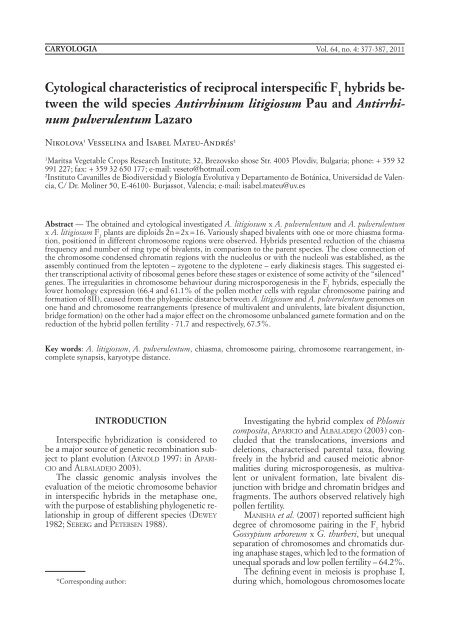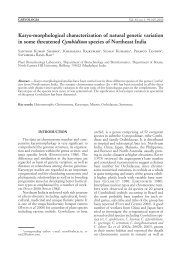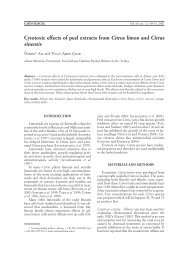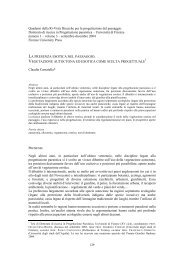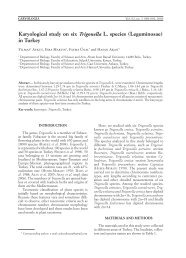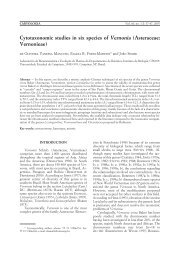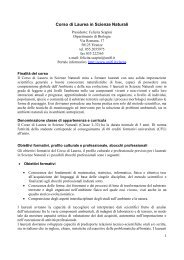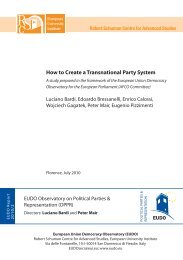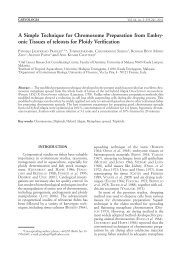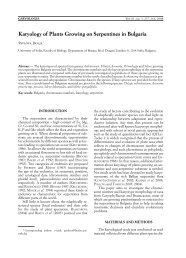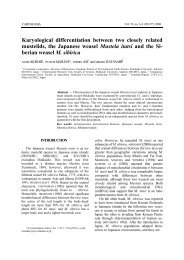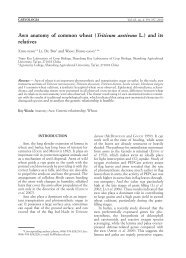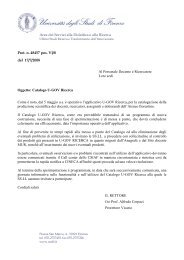Cytological characteristics of reciprocal interspecific F hybrids be ...
Cytological characteristics of reciprocal interspecific F hybrids be ...
Cytological characteristics of reciprocal interspecific F hybrids be ...
You also want an ePaper? Increase the reach of your titles
YUMPU automatically turns print PDFs into web optimized ePapers that Google loves.
CARYOLOGIA Vol. 64, no. 4: 377-387, 2011<br />
<strong>Cytological</strong> <strong>characteristics</strong> <strong>of</strong> <strong>reciprocal</strong> <strong>interspecific</strong> F 1<br />
<strong>hybrids</strong> <strong>be</strong>tween<br />
the wild species Antirrhinum litigiosum Pau and Antirrhinum<br />
pulverulentum Lazaro<br />
Nikolova 1 Vesselina and Isa<strong>be</strong>l Mateu-Andrés 2<br />
1<br />
Maritsa Vegetable Crops Research Institute; 32, Brezovsko shose Str. 4003 Plovdiv, Bulgaria; phone: + 359 32<br />
991 227; fax: + 359 32 650 177; e-mail: veseto@hotmail.com<br />
2<br />
Instituto Cavanilles de Biodiversidad y Biología Evolutiva y Departamento de Botánica, Universidad de Valencia,<br />
C/ Dr. Moliner 50, E-46100- Burjassot, Valencia; e-mail: isa<strong>be</strong>l.mateu@uv.es<br />
Abstract — The obtained and cytological investigated A. litigiosum x A. pulverulentum and A. pulverulentum<br />
x A. litigiosum F 1<br />
plants are diploids 2n = 2x = 16. Variously shaped bivalents with one or more chiasma formation,<br />
positioned in different chromosome regions were observed. Hybrids presented reduction <strong>of</strong> the chiasma<br />
frequency and num<strong>be</strong>r <strong>of</strong> ring type <strong>of</strong> bivalents, in comparison to the parent species. The close connection <strong>of</strong><br />
the chromosome condensed chromatin regions with the nucleolus or with the nucleoli was established, as the<br />
assembly continued from the leptoten – zygotene to the dyplotene – early diakinesis stages. This suggested either<br />
transcriptional activity <strong>of</strong> ribosomal genes <strong>be</strong>fore these stages or existence <strong>of</strong> some activity <strong>of</strong> the “silenced”<br />
genes. The irregularities in chromosome <strong>be</strong>haviour during microsporogenesis in the F 1<br />
<strong>hybrids</strong>, especially the<br />
lower homology expression (66.4 and 61.1% <strong>of</strong> the pollen mother cells with regular chromosome pairing and<br />
formation <strong>of</strong> 8II), caused from the phylogenic distance <strong>be</strong>tween A. litigiosum and A. pulverulentum genomes on<br />
one hand and chromosome rearrangements (presence <strong>of</strong> multivalent and univalents, late bivalent disjunction,<br />
bridge formation) on the other had a major effect on the chromosome unbalanced gamete formation and on the<br />
reduction <strong>of</strong> the hybrid pollen fertility - 71.7 and respectively, 67.5%.<br />
Key words: A. litigiosum, A. pulverulentum, chiasma, chromosome pairing, chromosome rearrangement, incomplete<br />
synapsis, karyotype distance.<br />
*Corresponding author:<br />
INTRODUCTION<br />
Interspecific hybridization is considered to<br />
<strong>be</strong> a major source <strong>of</strong> genetic recombination subject<br />
to plant evolution (Arnold 1997: in Aparicio<br />
and Albaladejo 2003).<br />
The classic genomic analysis involves the<br />
evaluation <strong>of</strong> the meiotic chromosome <strong>be</strong>havior<br />
in <strong>interspecific</strong> <strong>hybrids</strong> in the metaphase one,<br />
with the purpose <strong>of</strong> establishing phylogenetic relationship<br />
in group <strong>of</strong> different species (Dewey<br />
1982; Se<strong>be</strong>rg and Petersen 1988).<br />
Investigating the hybrid complex <strong>of</strong> Phlomis<br />
composita, Aparicio and Albaladejo (2003) concluded<br />
that the translocations, inversions and<br />
deletions, characterised parental taxa, flowing<br />
freely in the hybrid and caused meiotic abnormalities<br />
during microsporogenesis, as multivalent<br />
or univalent formation, late bivalent disjunction<br />
with bridge and chromatin bridges and<br />
fragments. The authors observed relatively high<br />
pollen fertility.<br />
Manisha et al. (2007) reported sufficient high<br />
degree <strong>of</strong> chromosome pairing in the F 1<br />
hybrid<br />
Gossypium arboreum x G. thur<strong>be</strong>ri, but unequal<br />
separation <strong>of</strong> chromosomes and chromatids during<br />
anaphase stages, which led to the formation <strong>of</strong><br />
unequal sporads and low pollen fertility – 64.2%.<br />
The defining event in meiosis is prophase I,<br />
during which, homologous chromosomes locate
378<br />
vesselina and mateu-andrés<br />
each other, physically connect, and exchange genetic<br />
information (recombination <strong>of</strong> the genetic<br />
material). The degree <strong>of</strong> recombination can <strong>be</strong><br />
determined by observing the chiasma formation.<br />
According to Darlington (1931), localisation<br />
<strong>of</strong> the chiasmata occurred in particular regions<br />
along a bivalent. The genetic control <strong>of</strong> the chiasma<br />
creation has <strong>be</strong>en supposed by Darlington<br />
(1937), Rees (1955), Rees and Thompson<br />
(1956), Roseveir and Rees (1962) and Rees and<br />
Jones (1977). John and Lewis (1965) concluded<br />
that the chiasmata decrease or are completely<br />
absent in the heterochromatin chromosome regions.<br />
The genus Antirrhinum L. (2n = 2x = 16) has<br />
some 25 species, all <strong>of</strong> them perennial diploid<br />
plants, distributed in the Mediterranean area<br />
(Sutton 1988). The I<strong>be</strong>rian Peninsula is their<br />
centre <strong>of</strong> diversification, as 23 species are natural<br />
from this area.<br />
As a model system, the ornamental species<br />
A. majus L. has <strong>be</strong>en genetically and molecularly<br />
well investigated (Schmidt and Kudla 1966;<br />
Stub<strong>be</strong> 1966; Lai et al. 2002; Schwarz-Sommer<br />
et al. 2003). Some cytological (Sparrow et al.<br />
1942; Stein 1942; Berger et al. 1951; Stub<strong>be</strong><br />
1996) and molecular cytogenetic investigations<br />
(Zhang et al. 2004; Xue et al. 2009) have <strong>be</strong>en<br />
performed to reveal the origin and the nature <strong>of</strong><br />
A. majus. There is very limited information in<br />
the literature about chromosome morphology<br />
and meiotic chromosome <strong>be</strong>haviour in the wild<br />
Antirrhinum species and in their remote <strong>hybrids</strong>.<br />
The performed cytological study is the second<br />
step in our research programme. The purpose<br />
<strong>of</strong> this programme was to investigate the<br />
chromosome pairing at the early meiotic stages,<br />
the type <strong>of</strong> the bivalent configurations and some<br />
irregularities <strong>of</strong> the chromosome <strong>be</strong>haviour during<br />
microsporogenesis in three wild Antirrhinum<br />
species-A. litigiosum Pau, A. subbaeticum<br />
Güemes, Sánchez and Mateu and A. pulverulentum<br />
Lazaro and in their artificially obtained F 1<br />
<strong>hybrids</strong>. The data can <strong>be</strong> useful to gain information<br />
about karyotipic distance and relationships<br />
<strong>be</strong>tween the studied Antirrhinum species.<br />
Fig. 1 — Microsporogenesis in A. litigiosum x A. pulverulentum F1 plants-Diakinesis: (a) normal, (b, c, d) with 2,4 and<br />
6I, (e, f, g) with different shaped IV; MI: h-normal, (i, j) with 2-4I, (k, l) with IV formation, (m, n) MI with abnormalities;<br />
AI: (o) normal, (p, q, r, s) with lagging chromosomes and bridge formation; (t) MII; AII: u-normal, (v, w) with<br />
irregularities; (y) tetrads, dyads; z- pollen.
cytological <strong>characteristics</strong> <strong>of</strong> <strong>hybrids</strong> <strong>be</strong>tween antirrhinum litigiosum and a. pulverulentum 379<br />
MATERIALS AND METHODS<br />
Microsporogenesis and some bivalent <strong>characteristics</strong><br />
were investigated in pollen mother<br />
cells (PMCs) <strong>of</strong> two <strong>reciprocal</strong> <strong>interspecific</strong> F 1<br />
<strong>hybrids</strong> – A. litigiosum x A. pulverulentum and<br />
A. pulverulentum x A. litigiosum – in the laboratory<br />
<strong>of</strong> the Department <strong>of</strong> Botany - Valencia<br />
University, Spain in 2010. The <strong>hybrids</strong> were obtained<br />
by hand pollination during 2009, as the<br />
F 1<br />
plants from the combination <strong>be</strong>tween four A.<br />
litigiosum plants (No1, 1/3, 1/4 and No 3) and<br />
pollinator A. pulverulentum No2/1 and from<br />
<strong>reciprocal</strong> cross A. pulverulentum 2/1 x A. litigiosum<br />
1 were grown in greenhouse conditions<br />
during 2009/2010. Ten F 1<br />
plants: No1, 2 (P 1<br />
A.<br />
litigiosum 1); No3, 4, 5 (P 1<br />
A. litigiosum 1/3); No<br />
6, 7, 8, 9 (P 1<br />
A. litigiosum 1/4) and No 10 (P 1<br />
A.<br />
litigiosum 3) and five <strong>reciprocal</strong> F 1<br />
<strong>hybrids</strong> were<br />
studied cytologically. For the evaluation <strong>of</strong> the<br />
meiotic chromosome <strong>be</strong>haviour, flower buds <strong>of</strong><br />
different size were fixed in 3:1 ethanol:glacial<br />
acetic acid fixative during the blossoming period.<br />
The slides were obtained by temporary<br />
squash preparations and stained with 4% acetocarmine<br />
solution.<br />
The bivalent <strong>characteristics</strong> were descri<strong>be</strong>d<br />
at pachytene, diplotene and early diakinesis stages.<br />
The chromosome associations and frequencies<br />
<strong>of</strong> meiotic configurations were recorded<br />
at diakinesis and metaphase one, as about 100<br />
pollen mother cells (PMCs) were scored from<br />
every studied plant. Some disturbances <strong>of</strong> the<br />
chromosome <strong>be</strong>havior were noted at metaphase,<br />
anaphase and telophase stages.<br />
Pollen fertility was estimated by acetocarmine<br />
staining, as the unstained pollen grains<br />
were recognized as sterile.<br />
RESULTS<br />
Chromosome associations and bivalent configurations<br />
- The obtained and cytologically investigated<br />
A. litigiosum x A. pulverulentum and<br />
A. pulverulentum x A. litigiosum F 1<br />
plants are<br />
diploids 2n = 2x = 16, as their progenitors. In the<br />
performed research a simultaneous type <strong>of</strong> the<br />
microsporogenesis was found in the studied hybrid<br />
PMCs.<br />
The level <strong>of</strong> synchrony <strong>of</strong> the initial meiotic<br />
stages (leptotene, pachytene and diplotene) and<br />
at the diakinesis, methaphase (one and second<br />
- MI and MII), anaphase (one and second - AI<br />
and AII) and tetrad formation were higher then<br />
the one, descri<strong>be</strong>d in the wild progenitors in<br />
2009. Most frequently, subsequent phases <strong>of</strong> the<br />
microgametogenesis were quite synchronic processes.<br />
Formation <strong>of</strong> two nucleoli in the meiocyte<br />
nucleus <strong>of</strong>ten occurred in the investigated hybrid<br />
plants.<br />
Table 1 — Chromosome associations at diakinesis and metaphase one in pollen mother cells (PMCs) <strong>of</strong> A. litigiosum<br />
x A. pulverulentum F1 plants.<br />
Chromosome<br />
associations<br />
Plant<br />
No 1<br />
Plant<br />
No2<br />
Plant<br />
No 3<br />
Plant<br />
No 4<br />
Polen mother cells - %<br />
8II 63.4 70.0 66.7 58.9 56.0 75.2 65.0 72.4 69.3 67.8 66.4<br />
8II + fragment 0.4 0.0 0.0 0.0 0.0 0.0 1.0 0.0 0.0 0.0 0.2<br />
7II + 2I 19.3 17.9 25.2 27.2 28.3 18.3 22.8 18.6 22.9 20.1 21.8<br />
6II + 4I 10.7 5.3 4.1 6.7 8.2 3.9 7.8 6.5 6.5 7.5 6.9<br />
6II + 1IV 1.6 3.7 2.7 5.0 1.3 2.0 1.0 1.0 0.0 1.7 2.0<br />
5II + 6I 2.5 0.0 0.0 0.6 4.4 0.7 1.5 1.0 0.0 2.9 1.4<br />
5II + 2I + 1IV 1.2 1,6 1.4 1.1 0.6 0.0 0.5 0.0 1.3 0.0 0.8<br />
4II + 8I 0.8 0.0 0.0 0.0 1.3 0.0 0.0 0.5 0.0 0.0 0.3<br />
4II + 4I + 1IV 0.0 1.0 0.0 0.0 0.0 0.0 0.0 0.0 0.0 0.0 0.1<br />
3II + 10I 0.0 0.5 0.0 0.0 0.0 0.0 0.5 0.0 0.0 0.0 0.1<br />
2II+5I+1III+1IV 0.0 0.0 0.0 0.6 0,0 0.0 0.0 0.0 0.0 0.0 0.1<br />
Investigated PMCs 243 190 147 180 159 153 206 199 153 174 1804<br />
Pollen fertility 63.6 70.7 83.4 79.1 72.8 70.4 63.0 72.5 70.9 70.5 71.7<br />
Plant<br />
No 5<br />
Plant<br />
No 6<br />
Plant<br />
No 7<br />
Plant<br />
No 8<br />
Plant<br />
No 9<br />
Plant<br />
No10<br />
Average
380<br />
vesselina and mateu-andrés<br />
The data from Tables 1, 2 and 3 demonstrates<br />
various chromosome associations and the average<br />
frequency <strong>of</strong> chromosome configurations at<br />
diakinesis and metaphase one in PMCs <strong>of</strong> the<br />
studied F 1<br />
progeny.<br />
The homologous chromosomes paired and<br />
formed 8 bivalents (II) in 56.0 to 75.2% (average<br />
value - 66.4%) <strong>of</strong> the PMCs in the F 1<br />
A. litigiosum<br />
x A. pulverulentum plants (Table 1) (Figs.<br />
1a, h). The normal chromosome conjugation<br />
varied among the investigated ten F 1<br />
<strong>hybrids</strong><br />
(VC 34.7%). The data from Table 1 showed that<br />
the disruption <strong>of</strong> chromosome pairing is clearly<br />
expressed in A. litigiosum 1/3 x A. pulverulentum<br />
2/1 plants. In the <strong>reciprocal</strong> cross the 8II<br />
were descri<strong>be</strong>d in 58.3 to 65.8% <strong>of</strong> the cells (VC<br />
Table 2 — Chromosome associations at diakinesis and metaphase one in pollen mother cells (PMCs) <strong>of</strong> A. pulverulentum<br />
x A. litigiosum F 1<br />
plants.<br />
Chromosome<br />
associations<br />
Pollen mother cells - %<br />
Plant No1 Plant No2 Plant No3 Plant No4 Plant No5 Average<br />
8II 56.0 62.1 58.3 65.8 63.3 61.1<br />
7II + 2I 24.1 23.3 20.5 21.1 21.8 22.1<br />
6II + 4I 11.2 9.5 12.1 4.4 8.2 9.1<br />
6II + 1IV 0.0 2.6 1.5 3.5 1.4 1.8<br />
6II + 1III + 1I 0.0 0.0 0.0 0.0 0.7 0.1<br />
5II + 6I 4.3 1.7 6.8 2.6 2.7 3.7<br />
5II + 2I +1IV 0.9 0.0 0.0 0.9 0.6 0.5<br />
4II + 8I 2.6 0.9 0.8 0.0 0.0 0.8<br />
3II + 10I 0.9 0.0 0.0 0.0 1.2 0.5<br />
2II + 12I 0.0 0.0 0.0 0.9 0.0 0.1<br />
16I 0.0 0.0 0.0 0.9 0.0 0.1<br />
Investigated PMCs 116 116 132 114 147 625<br />
Pollen fertlity 76.8 62.6 64.8 66.9 66.3 67.5<br />
Fig. 2 — Microsporogenesis in A. pulverulentum x A. litigiosum F1 plants-Diakinesis: (a) normal, (b, c, d) with 2,4and<br />
6I (e, f) with multivalents; MI: (g) normal, (h) with 2I, (i) with IV formation; AI: (j) normal, (k, l, m)with lagging chromosome<br />
and bridge formation; AII: (n, o, p) with irregularities; (q, r) tetrads, dyad and polyad; s- pollen.
cytological <strong>characteristics</strong> <strong>of</strong> <strong>hybrids</strong> <strong>be</strong>tween antirrhinum litigiosum and a. pulverulentum 381<br />
15.4%) (Table2) (Figs. 2a, g). The average frequency<br />
<strong>of</strong> bivalent configurations per PMC was<br />
similar in the two <strong>hybrids</strong> - 7.51 and respectively<br />
7.36II per cell (Table 3).<br />
In the <strong>interspecific</strong> <strong>hybrids</strong>, the type <strong>of</strong> the<br />
observed bivalent configurations varied significantly<br />
at pachytene stage. Formation <strong>of</strong> monochiasmatic<br />
bivalents, with single chiasma, always<br />
localized in the distal non-centromeric regions<br />
<strong>of</strong> the A. litigiosum and A. pulverulentum chromosomes,<br />
was detected in all investigated plants<br />
(Fig. 3a). The shortest A. litigiosum chromosome<br />
(Fig. 4e, Fig. 5d) (Nikolova and Mateu-Andrés<br />
2010) was included in the monochiasmatic bivalent<br />
frequently. Two, three or more chiasmata<br />
formation (Figs. 3 b, c, d, e) were registered in<br />
the remaining bivalents <strong>of</strong> the hybrid PMCs, as<br />
the chiasmata were positioned in different chromosome<br />
regions.<br />
At pachitene stage it was observed a condensed<br />
chromatin cluster situated in different<br />
chromosome regions (generally in the distal regions)<br />
(Fig. 4a, Fig. 5a) or two and more clusters<br />
(Fig. 4 c, Fig. 5b), as the observed clusters very<br />
<strong>of</strong>ten connected closely with the nucleolus or<br />
with the secondary nucleolus (Fig. 4d, Fig. 5c).<br />
Close assembly <strong>of</strong> the chromosome condensed<br />
chromatin regions with the nucleoli continued<br />
from the leptotene –zygotene to the diplotene –<br />
early diakinesis stages.<br />
The data, obtained from about 50% <strong>of</strong> the<br />
studied at diakinesis and MI cells, regarding the<br />
bivalent type, the total chiasmata and the mean<br />
chiasma per bivalent is shown in Table 4. The<br />
higher value <strong>of</strong> ring bivalents (3.36), total chiasmata<br />
(11.03) and mean chiasma num<strong>be</strong>r per<br />
bivalent (1.44) was found in A. litigiosum x A.<br />
pulverulentum PMCs, while the lower value <strong>of</strong><br />
these <strong>characteristics</strong> was established in the A.<br />
pulverulentum x A. litigiosum cells (2.94, 10.58<br />
and respectively 1.38).<br />
Abnormalities <strong>of</strong> chromosome pairing - In case<br />
<strong>of</strong> incomplete synapsis or <strong>of</strong> early chiasma terminalisation,<br />
<strong>be</strong>tween 2 and 10 univalents (I) were<br />
formed at diakinesis and MI (average frequency<br />
0.85I per cell) in 23.0 to 42.2% (VC35.3%) <strong>of</strong><br />
PMCs in A. litigiosum x A. pulverulentum F 1<br />
plants (Figs. 1 b, c, d, i, j). Higher num<strong>be</strong>r <strong>of</strong><br />
Fig. 3 — Different shaped bivalents in PMCs <strong>of</strong> A.litigiosum x A.pulverulentum F1 plants with: (a) one chiasma; (b)<br />
two chiasmata; (c, d) more than two chiasmata; (e) different shaped bivalents associated with nucleolus.
382<br />
vesselina and mateu-andrés<br />
univalents (from 2 to 16I) (1.19 per PMC) and<br />
higher percentage <strong>of</strong> the cells (ranged <strong>be</strong>tween<br />
30 and 43.1% - VC 23.8%) with univalents were<br />
established in the <strong>reciprocal</strong> cross (Figs. 2 b, c, d,<br />
h). In general, two chromosomes did not pair and<br />
the association 7II+2I was the most frequently<br />
observed in studied PMCs <strong>of</strong> the both <strong>hybrids</strong><br />
(Table 1 and Table 2). Our data showed that in<br />
the F 1<br />
progeny, the incomplete synapsis was expressed<br />
stronger in comparison with the parent<br />
components (30.0% and 16.4% <strong>of</strong> the PMCs<br />
with 2 to10I in A. litigiosum and respectively<br />
in A. pulverulentum cells). Formation <strong>of</strong> a differently<br />
shaped quadrivalent configuration (IV)<br />
(Figs.1e, f, g, k, l; Figs. 2e, i) or a trivalent (III)<br />
+ univalent (Fig. 2f) were established in 2.4 and<br />
respectively 3.0% <strong>of</strong> the cells in the F 1<br />
plant from<br />
the two crosses. An additional small fragment to<br />
the 8II in A. litigiosum x A. pulverulentum PMCs<br />
was descri<strong>be</strong>d at diakinesis. The fragmentation<br />
<strong>of</strong> small region <strong>of</strong> the chromosomes and two additional<br />
fragments were noticed in some A. litigiosum<br />
PMCs in 2009. Early orientation <strong>of</strong> up to<br />
4I toward the spindle poles (Fig. 1m, n) and 1II<br />
outside <strong>of</strong> the metaphases plate was among the<br />
other disturbances during the above mentioned<br />
stages, as the percentage <strong>of</strong> PMCs with this type<br />
<strong>of</strong> irregularities ranged from 2.8 to 9.9% in A.<br />
litigiosum x A. pulverulentum F 1<br />
plants and from<br />
4.2 to 16.6% in the <strong>reciprocal</strong> hybrid.<br />
Chromosome <strong>be</strong>haviour at anaphase stages -<br />
Independently <strong>of</strong> the significant num<strong>be</strong>r <strong>of</strong> the<br />
Table 3 — Average frequency <strong>of</strong> chromosome configurations at diakinesis and methaphase one per pollen mother cell<br />
(PMC) <strong>of</strong> A. litigiosum x A. pulverulentum and A. pulverulentum x A. litigiosum F 1<br />
plants.<br />
Hybrids II I III IV fragments<br />
A. litigiosum x A. pulverulentum 7.51 0.85 0.005 0.03 0.002<br />
A. pulverulentum x A. litigiosum 7.36 1.19 0.001 0.02 0.0<br />
Table 3 — Average frequency <strong>of</strong> chromosome configurations at diakinesis and methaphase one per pollen mother cell<br />
(PMC) <strong>of</strong> A. litigiosum x A. pulverulentum and A. pulverulentum x A. litigiosum F 1<br />
plants.<br />
Hybrids II I III IV fragments<br />
A. litigiosum x A. pulverulentum 7.51 0.85 0.005 0.03 0.002<br />
A. pulverulentum x A. litigiosum 7.36 1.19 0.001 0.02 0.0<br />
Fig. 4 — Assembly <strong>of</strong> the nucleoli with chromatin condensed chromosome regions in A. litigiosum x A. pulverulentum<br />
F1 PMCs: (a) one cluster connection; (b) including in connection <strong>of</strong> the shortest A. litigiosum chromosome; (c) two<br />
and more cluster connection; (d) assembly <strong>of</strong> the secondary nucleoli with chromatin condensed regions; (e) the shortest<br />
A. litigiosum chromosome.
cytological <strong>characteristics</strong> <strong>of</strong> <strong>hybrids</strong> <strong>be</strong>tween antirrhinum litigiosum and a. pulverulentum 383<br />
cells with univalent formation and early orientation<br />
<strong>of</strong> up to 4 univalents toward the spindle<br />
poles, the high percentages <strong>of</strong> the PMCs (average<br />
90.1 and 84.8% in the <strong>reciprocal</strong> <strong>hybrids</strong>)<br />
showed equal chromosome distribution at AI<br />
stage and 8-8 chromosome num<strong>be</strong>r in the spindle<br />
poles (Fig. 1o; Fig. 2j). Some abnormalities<br />
(late bivalent disjunction, up to 4 lagging chromosomes,<br />
unbalanced num<strong>be</strong>r <strong>of</strong> chromosomes<br />
in the spindle poles, bridge formation - one or<br />
two in A. litigiosum x A. pulverulentum F 1<br />
plant<br />
and one bridge in the <strong>reciprocal</strong> cross, early division<br />
<strong>of</strong> the univalents to the chromatids) were<br />
defined in the remaining cells. (Figs. 1p, q, r,<br />
s; Figs. 2k, l, m). The meiotic chromosome <strong>be</strong>haviour<br />
at second metaphase and anaphase was<br />
analogical to that one observed in the MI and<br />
AI. Regular chromosome distribution toward<br />
the spindle poles at AII was registered in 87 to<br />
99% <strong>of</strong> the PMCs in A. litigiosum x A. pulverulentum<br />
F 1<br />
plants (Fig. 1u) and in 85 to 95% in<br />
the cells <strong>of</strong> the <strong>reciprocal</strong> cross. More frequently<br />
in the one spindle, up to 2 and respectively to<br />
4 lagging chromosomes, bridge formation, chromosomes<br />
outside <strong>of</strong> the division spindle and aneuploid<br />
chromosome num<strong>be</strong>r in the poles <strong>of</strong> the<br />
PMCs in the studied <strong>hybrids</strong> was possible to detect<br />
(Figs. 1t, v, w; Figs. 2 n, o, p). In some cells,<br />
appearance <strong>of</strong> two bridges in the two spindles,<br />
three-pole orientations <strong>of</strong> the chromosomes and<br />
unsynchronized division were established.<br />
Microspore formation and pollen fertility - In<br />
all investigated A. litigiosum x A. pulverulentum<br />
and A. pulverulentum x A. litigiosum F 1<br />
plants,<br />
the microsporogenesis finished with cytokinesis<br />
after second telophase (TII) and tetrad forma-<br />
Table 4 — Some <strong>characteristics</strong> <strong>of</strong> the bivalents in A. litigiosum x A. pulverulentum and A. pulverulentum x A. litigiosum<br />
F 1<br />
plants.<br />
Hybrids<br />
| A. litigiosum<br />
| x<br />
| A. pulverulentum<br />
A. pulverulentum<br />
x<br />
A. litigiosum<br />
Studied PMCs<br />
num<strong>be</strong>r<br />
Ring<br />
bivalents<br />
mean num<strong>be</strong>r<br />
Rod<br />
bivalents<br />
mean num<strong>be</strong>r<br />
Chiasmata<br />
per PMC<br />
mean num<strong>be</strong>r<br />
Chiasmata<br />
per bivalent<br />
mean num<strong>be</strong>r<br />
Univalents<br />
mean num<strong>be</strong>r<br />
Quadrivalent<br />
mean num<strong>be</strong>r<br />
778 3.36 4.40 11.03 1.44 0.61 0.008<br />
326 2.94 4.73 10.58 1.38 0.79 0.00<br />
Fig. 5 — Assembly <strong>of</strong> the nucleoli with chromatin condensed chromosome regions in A. pulverulentum x A. litigiosum<br />
F1 PMCs: (a) one cluster connection; (b) two and more cluster connection; (c) assembly <strong>of</strong> the secondary nucleolus<br />
with chromatin condensed regions; (d) the shortest A. litigiosum chromosome.
384<br />
vesselina and mateu-andrés<br />
tion in about 98.8-100% and respectively in 93.0<br />
to 100% <strong>of</strong> the cells. As in the progenitors, according<br />
to the position <strong>of</strong> the division spindles<br />
at MII, two types <strong>of</strong> tetrads-isobilateral or tetrahedral,<br />
in different proportion (Fig. 1y; Fig.<br />
2q) were established together in the PMCs <strong>of</strong><br />
the studied <strong>hybrids</strong>. Meiotic abnormalities originated<br />
dyad, triad and polyad formation (Fig. 1z;<br />
Fig. 2 r) in some PMCs.<br />
The data from Table 1 showed that the disruption<br />
<strong>of</strong> the regular chromosome pairing<br />
probably resulted in the reduction <strong>of</strong> the pollen<br />
fertility (Table 1) (Fig. 1x; Fig. 2s). The relation<br />
<strong>be</strong>tween the percentage <strong>of</strong> the PMCs with regular<br />
chromosome pairing and the pollen fertility<br />
is clearly demonstrated in the investigated hybrid<br />
plants, as only in the progeny <strong>of</strong> the cross<br />
<strong>be</strong>tween A. litigiosum 1/3 and A. pulverulentum<br />
2/1 and in plant No1 from the <strong>reciprocal</strong> cross<br />
this relation did not exists.<br />
The pollen grains <strong>of</strong> the studied <strong>hybrids</strong> were<br />
tricolporate with small generative cell and did<br />
not morphologically differ from those the ones<br />
descri<strong>be</strong>d in the two wild Antirrhinum progenitors.<br />
The tapetal cells were generally binucleate at<br />
early prophase and, very frequently, there were<br />
more than two nucleoli. At meiotic pachytene<br />
some tapetal cells possessed three or four nuclei.<br />
After endomitotic cycles, tetraploid and octoploid<br />
chromosome num<strong>be</strong>r in the poles <strong>of</strong> the<br />
tapetal cells was observed.<br />
DISCUSSION<br />
The cytologically investigated A. litigiosum<br />
x A. pulverulentum and A. pulverulentum x<br />
A. litigiosum F 1<br />
plants had a diploid genome<br />
2n = 2x = 16, as their progenitors and a simultaneous<br />
type <strong>of</strong> the microsporogenesis was pre-<br />
Fig. 6 — Ribosome formation in A. pulverulentum x A.<br />
litigiosum F1 PMCs (a) in distal regions, (b) along <strong>of</strong> the<br />
chromosome arm.<br />
sented in all <strong>of</strong> them.<br />
The type <strong>of</strong> the observed bivalent configurations<br />
in PMCs <strong>of</strong> A. litigiosum x A. pulverulentum<br />
and A. pulverulentum x A. litigiosum F 1<br />
plants varied significantly at pachytene stage and<br />
was more varying then that one descri<strong>be</strong>d in the<br />
wild parent components (Nikolova and Mateu-<br />
Andrés 2010). Formation <strong>of</strong> monochiasmatic<br />
bivalent, with single chiasma always localized<br />
in the distal non-centromeric regions <strong>of</strong> the A.<br />
litigiosum and A. pulverulentum chromosomes<br />
was descri<strong>be</strong>d in all investigated plants. The<br />
observed in 2009 shortest A. litigiosum chromosome<br />
which had condensed heterochromatin<br />
concentrated in the telomeric regions, was very<br />
<strong>of</strong>ten involved in this pair. The bivalents with<br />
two chiasmata formation positioned in different<br />
chromosome regions, either only terminally or<br />
terminally and proximally, were registered. Some<br />
bivalents were asymmetric, having one chiasma<br />
in the terminal part <strong>of</strong> the two chromosomes and<br />
the second one <strong>be</strong>tween distal and centromeric<br />
regions respectively. The presence <strong>of</strong> a butterflytype<br />
bivalent, as that one descri<strong>be</strong>d in the progenitors<br />
(Nikolova and Mateu-Andrés 2010)<br />
and bivalents with various complicated shape<br />
with three or more chiasma formation, were observed<br />
in the investigated hybrid PMCs.<br />
The chiasmata frequency differs <strong>be</strong>tween<br />
the genotypes and <strong>be</strong>tween the female and male<br />
reproductive cells, as chiasmata formation and<br />
distribution is controlled genetically (Darlington<br />
1937; Rees 1955; Rees and Thompson 1956;<br />
Roseveir and Rees 1962; Rees and Jones 1977),<br />
or caused by mutation, or influenced by the environmental<br />
conditions.<br />
The data, regarding the bivalent type, the<br />
total chiasmata and the mean chiasma num<strong>be</strong>r<br />
per bivalent showed higher value <strong>of</strong> ring bivalents<br />
(3.36), total chiasmata (11.03) and mean<br />
chiasma num<strong>be</strong>r per bivalent (1.44) in A. litigiosum<br />
x A. pulverulentum PMCs, while the lower<br />
value <strong>of</strong> these <strong>characteristics</strong> was established in<br />
the A. pulverulentum x A. litigiosum cells (2.94,<br />
10.58 and respectively 1.38). Our previous studies<br />
(Nikolova and Mateu-Andrés 2010) showed<br />
that the PMC <strong>of</strong> the wild species A. litigiosum<br />
and A. pulverulentum had higher values <strong>of</strong> ring<br />
bivalents (4.17 and 5.78), total chiasmata (12.11<br />
and 14.04) and mean chiasma num<strong>be</strong>r per bivalent<br />
(1.51 and 1.76 respectively), compared to the<br />
ones established in their <strong>hybrids</strong>. The increase <strong>of</strong><br />
rod type <strong>of</strong> bivalents in hybrid cells (4.40 and<br />
4.73 in PMCs <strong>of</strong> the <strong>reciprocal</strong> crosses - 3.67<br />
and 2.22 respectively in the parent components)
cytological <strong>characteristics</strong> <strong>of</strong> <strong>hybrids</strong> <strong>be</strong>tween antirrhinum litigiosum and a. pulverulentum 385<br />
is probably due to reduction <strong>of</strong> chiasma formation.<br />
Genes controlling chiasma formation and<br />
position in the progenitors may have changed<br />
function in the <strong>hybrids</strong> and led to reduction <strong>of</strong><br />
the chiasma frequency. Such <strong>be</strong>haviour has <strong>be</strong>en<br />
reported in cotton and rapeseed cultivars and in<br />
their <strong>hybrids</strong> by Sheida et al. (1998) and Sheida<br />
et al. (2003).<br />
The nucleolus controls functions necessary<br />
for the synthesis <strong>of</strong> ribosomes and positioned<br />
at the site <strong>of</strong> the chromosomal nucleolar organizer<br />
regions (NORs). In the hybrid genome the<br />
NORs possess either active or transcriptional inactive<br />
rDNA genes. According to Flavell et al.<br />
(1988) and Thompson et al. (1988), the inactive<br />
rDNA genes are packaged into a transcriptionally<br />
inactive chromatin structure. Lawrence and<br />
Pikaard (2004) concluded that chromatin modification<br />
is an important component <strong>of</strong> the regulatory<br />
network that controls the effective dosage<br />
<strong>of</strong> active rDNA genes.<br />
At pachytene stage we have seen a condensed<br />
chromatin cluster, situated in different chromosome<br />
regions (generally in the distal regions) or<br />
two and more clusters, as the clusters mostly<br />
connected very closely with nucleolus or with<br />
two nucleoli in the studied hybrid PMCs. The<br />
shortest A. litigiosum chromosome, with condensed<br />
heterochromatin concentrated in the<br />
telomeric regions, was associated with nucleoli<br />
very frequently (Fig.4b). The closely assembly <strong>of</strong><br />
the clusters with the nucleoli visually continued<br />
from the leptoten – zygotene to the dyplotene<br />
– early diakinesis stages. Mapping <strong>of</strong> the major<br />
heterochromatin domains in the Antirrhinun<br />
majus genome, Zhang et al. (2005) founded that<br />
in general, heterochromatin is mainly located in<br />
the pericentric regions, as in chromosome 3, 4<br />
and 6 major heterochromatin domain are located<br />
et the ends <strong>of</strong> their short arms.<br />
According to Montijn et al. (1998), in early<br />
mitotic prophase <strong>of</strong> plants <strong>of</strong> two Petunia hybrida<br />
varieties, the condensed two chromatin<br />
clusters <strong>of</strong> chromosome 3 are not associated<br />
with the nucleolus and their ribosomal genes are<br />
transcriptionally inactive.<br />
The close assembling <strong>of</strong> the chromosome<br />
condensed chromatin regions with the nucleoli<br />
in the observed hybrid cells and the continuance<br />
<strong>of</strong> the period (from the leptotene – zygotene to<br />
the diplotene – early diakinesis stages), in which<br />
the connection <strong>of</strong> these regions and nucleoli<br />
were presented, suggest either transcriptional<br />
activity <strong>of</strong> ribosomal genes <strong>be</strong>fore these stages or<br />
existence <strong>of</strong> some activity <strong>of</strong> the silenced genes.<br />
The creation <strong>of</strong> ribosomes near to the distal regions<br />
<strong>of</strong> some chromosomes (Fig. 6a) or along<br />
<strong>of</strong> the chromosomal arms (Fig. 6a) at pachytene<br />
stage was detected. In the classic cytological<br />
study the estimation <strong>of</strong> the chromosome pairing<br />
and formation <strong>of</strong> bivalent configurations, preferably<br />
at diakinesis, (when this is not possible in<br />
prophase) is used as an indicator <strong>of</strong> the relation<br />
degree among the different species.<br />
In the performed meiotic study, the normal<br />
chromosome conjugation and formation <strong>of</strong> 8II<br />
at diakinesis and MI were recognized in average<br />
66.4 and 61.1% <strong>of</strong> the PMCs in A. litigiosum x<br />
A. pulverulentum and respectively A. pulverulentum<br />
x A. litigiosum F 1<br />
plants. The percentage <strong>of</strong><br />
the PMCs with regular chromosome pairing was<br />
smaller and differed from that one established in<br />
the progenitors (Nikolova and Mateu-Andrés<br />
2010) – 71.6% in A. litigiosum and 82.1% in<br />
A. pulverulentum plants. One <strong>of</strong> the reasons <strong>of</strong><br />
the lower homology expression is probably the<br />
karyotipe differences <strong>be</strong>tween these wild species<br />
or the genetic system, controlling the regular<br />
chromosome pairing, act differently in the hybrid<br />
genomes. Increasing the percentage <strong>of</strong> the<br />
cells with meiotic abnormalities such: multivalent<br />
formation (2.4 and respectively 3.0% <strong>of</strong> the<br />
hybrid PMCs – 1.5% <strong>of</strong> the wild species cells);<br />
presence <strong>of</strong> higher num<strong>be</strong>r <strong>of</strong> univalents (in 31.5<br />
and 36.4% <strong>of</strong> PMCs in the F 1<br />
plants – in 30 and<br />
16.5% <strong>of</strong> the progenitor cells); bridge formation<br />
(in 3.9 and 5.1% <strong>of</strong> the hybrid PMCs and 1.3 and<br />
2.0% – in parent components) and bivalent late<br />
disjunction, all <strong>of</strong> this indicated for escalating <strong>of</strong><br />
the heterozygous chromosome rearrangements.<br />
The formation <strong>of</strong> a quadrivalent configuration<br />
probably was caused either by heterozygous<br />
translocation, concerning very small regions <strong>of</strong><br />
non-homologous chromosomes, or by presence<br />
<strong>of</strong> some homology <strong>be</strong>tween small terminal segments<br />
(X shaped quadrivalent configuration<br />
- Fig. 1g). According to Attia and Roblelen<br />
(1986), exhibition <strong>of</strong> multivalent creation reflects<br />
the pairing <strong>be</strong>tween homeologous chromosomes.<br />
Bridge formation suggested the occurrence<br />
<strong>of</strong> chromosomal inversion and/or translocation.<br />
According to Aparicio and Albaladejo (2003)<br />
the late bivalent disjunction related with bridge<br />
formation in hybrid complex <strong>of</strong> Phlomis composita.<br />
Sheida et al. (2003) linked chromosome<br />
stickiness and bridge formation in Brassica napus<br />
L. <strong>hybrids</strong>.<br />
The spindle abnormalities have led to the<br />
production <strong>of</strong> observed at AI and AII aneu-
386<br />
vesselina and mateu-andrés<br />
ploid type <strong>of</strong> chromosome distribution toward<br />
the spindle poles in up to 4.5% <strong>of</strong> the hybrid<br />
PMCs. Nirmala and Rao (1996) proposed different<br />
reasons for the occurrence <strong>of</strong> spindle<br />
abnormalities – duality <strong>of</strong> nucleus in foreign cytoplasm,<br />
environmental influence and disharmonious<br />
gene interaction. Another reason for the<br />
increased num<strong>be</strong>r <strong>of</strong> aborted aneuploid pollen<br />
grains probably is that the lagging chromosomes<br />
are not in time to <strong>be</strong> incorporated into the telophase<br />
nuclei.<br />
The above mentioned irregularities in chromosome<br />
<strong>be</strong>havior during microsporogenesis in<br />
the observed A. litigiosum x A. pulverulentum<br />
and A. pulverulentum x A. litigiosum F 1<br />
plants,<br />
especially on one hand lower homology expression,<br />
caused from the karyotipe differences<br />
<strong>be</strong>tween these wild species and on the other,<br />
chromosome rearrangements, had a major effect<br />
on the formation <strong>of</strong> the chromosome and gene<br />
unbalanced gamete and on the reduction <strong>of</strong> the<br />
pollen fertility - 71.7 and respectively 67.5%.<br />
The wild species A. litigiosum and A. pulverulentum<br />
showed a high value <strong>of</strong> this characteristic<br />
- pollen fertility 96.0 and respectively 98.4%<br />
(Nikolova and Mateu-Andrés 2010).<br />
The performed cytological investigation<br />
shows some influence <strong>of</strong> mother genotype on<br />
the meiotic chromosome <strong>be</strong>havior. The mikrosporogenesis<br />
runs with less irregularity in the A.<br />
litigiosum x A. pulverulentum meiocytes, then<br />
the one descri<strong>be</strong>d in the <strong>reciprocal</strong> cross, as the<br />
mother progenitor A. litigiosum No1/3 definite<br />
clearly exhibited disruption <strong>of</strong> chromosome<br />
pairing in comparison <strong>of</strong> the combination with<br />
P 1<br />
components A. litigiosum No 1, 1/4 and No<br />
3. The chromosome conjugation varied strongly<br />
among the investigated ten F 1<br />
A. litigiosum x A.<br />
pulverulentum plants, as A. pulverulentum x A.<br />
litigiosum genotypes were more constant in this<br />
characteristic.<br />
If we accept that the chromosome pairing<br />
and formation <strong>of</strong> bivalent configurations is used<br />
as an indicator <strong>of</strong> the degree <strong>of</strong> relation among<br />
the different species, we have to conclude that<br />
in genus Antirrhinum there is clearer expressed<br />
karyotype distance <strong>be</strong>tween wild species A. litigiosum<br />
and A. pulverulentum in comparison<br />
with the distances <strong>be</strong>tween the wild A. litigiosum<br />
- A. subbaeticum and A. pulverulentum - A.<br />
subbaeticum species. The regular pairing <strong>of</strong> the<br />
homologous chromosomes and formation <strong>of</strong> 8II<br />
in PMCs was observed: in 84.1 and 80.4% from<br />
the cells <strong>of</strong> the <strong>reciprocal</strong> crosses <strong>be</strong>tween progenitor’s<br />
A. litigiosum and A. subbaeticum (pollen<br />
fertility in F 1<br />
- 79.0%); in 88.8 and 85.0%<br />
<strong>of</strong> the PMCs in the F 1<br />
plants A. pulverulentum<br />
x A. subbaeticum and respectively A. subbaeticum<br />
x A. pulverulentum (pollen fertility 97.7 and<br />
95.0%) (unpublished data).<br />
REFERENCES<br />
Aparicio A. and Albaladejo R.G., 2003 — Mikrosporogenesis<br />
and meiotic abnormalities in the hybrid<br />
complex <strong>of</strong> Phlomis composita (Lamiaceae). Botanical<br />
Journal <strong>of</strong> the Linnean Society, 143: 79-85.<br />
Attia T. and Röblelen G., 1986 — Meiotic pairing in<br />
haploids and amphidiploids <strong>of</strong> spontaneous versus<br />
synthetic origin in rape Brassica napus L. Canadian<br />
Journal <strong>of</strong> Genetics and Cytology, 28: 330-334.<br />
Arnold M.L., 1997 — Natural hybridisation and<br />
evolution. New York: Oxford University Press.<br />
In: Aparicio A. and Albaladejo RG., 2003.<br />
Mikrosporogenesis and meiotic abnormalities in<br />
the hybrid complex <strong>of</strong> Phlomis composita (Lamiaceae).<br />
Botanical Journal <strong>of</strong> the Linnean Society,<br />
143: 79-85.<br />
Berger C.A, Whitkus E.R. and Joseph T.C., 1951 —<br />
Tapetal cell and meiotic divisions in Antirrhinum<br />
majus L. and Linaria Vulgaris Hill. Caryologia,<br />
4(1): 110-115.<br />
Darlington C.D., 1931. — Chiasma formation and<br />
chromosome pairing in Fritillaria. Proceedings <strong>of</strong><br />
the International Botany Congress, 189, 1.<br />
Darlington C.D., 1937 — Recent advances in cytology.<br />
London Chrurchill.<br />
Dewey D., 1982 — Genomic and phylogenetic relationships<br />
among North American perennial Triticeae.<br />
In: Estes et al. Grasses and grasslands: 51-81.<br />
University <strong>of</strong> Oklahoma Press, Oklahoma.<br />
Flavell R.B, O , Dell M. and Thompson W.F., 1988<br />
— Regulation <strong>of</strong> cytosine methylation in ribosomal<br />
DNA and nucleolus organizer expression in wheat.<br />
Journal <strong>of</strong> Molecular Biology, 204: 523-534.<br />
John B. and Lewis K.R., 1965 — The meiotic system.<br />
Protosplasmalogia, 6; Wien.<br />
Lai Z, Ma W, Han B, Liang L, Zhang Y et al., 2002<br />
— An F-box gene linked to the self- incompatibility<br />
(S) locus <strong>of</strong> Antirrhinum is expressed specifically in<br />
pollen and tapetum. Plant Molecular Biology, 50:<br />
29-42.<br />
Lawrence R.J. and Pikaard C.S., 2004 — Chromatin<br />
turn on and turn <strong>of</strong>fs <strong>of</strong> ribosomal RNA genes. Cell<br />
Cycle, 3(7): 880-883.<br />
Manisha K, Mehetre S, Gahukar S, Shinde G. and<br />
Patil V., 2007 — Cyto-morphological and RAPD<br />
analysis <strong>of</strong> F 1<br />
, F 2<br />
and BC 1<br />
generations <strong>of</strong> a cross<br />
Gossypium arboreum x Gossypium thur<strong>be</strong>ri. Caryologia,<br />
4: 379-388.<br />
Montijn M.B, ten Hoopen R, Fransz P.F, Oud J.L.<br />
and Nanninga N., 1998 — Characterization <strong>of</strong> the<br />
nucleolar organizing regions during the cell cycle in<br />
two varieties <strong>of</strong> Petunia Hybrida as visualized by<br />
fluorescence in situ hybridization and silver stain-
cytological <strong>characteristics</strong> <strong>of</strong> <strong>hybrids</strong> <strong>be</strong>tween antirrhinum litigiosum and a. pulverulentum 387<br />
ing. Chromosoma, 107: 80-86.<br />
Nikolova V. and Mateu- Andrés I., 2010 — Microsporogenesis<br />
in three wild species <strong>of</strong> the genus Antirrhinum<br />
L. (A. litigiosum Pau, A. pulverulentum<br />
Lazaro and A. subbaeticum Güemes, Sánchez and<br />
Mateu). Caryologia, 63(3): 262-268.<br />
Nirmala A. and Rao P.N, 1996 — Genesis <strong>of</strong> chromosome<br />
numerical mosaicism in higher plants. The<br />
nucleus, 39: 151-175.<br />
Rees H., 1955 — Genotypic control <strong>of</strong> chromosome<br />
<strong>be</strong>haviour in rye. I. Inbred lines. Heredity, 9: 93.<br />
Rees H. and Jones R., 1977 — Chromosome Genetics.<br />
Edward Arnold, London.<br />
Rees H. and Thompson J., 1956 — Genotypic control<br />
<strong>of</strong> chromosome <strong>be</strong>haviour in rye. III. Chiasma frequency<br />
in homozygotes and heterozygotes. Heredity,<br />
10: 409-424.<br />
Roseveir J. and Rees H., 1962 — Fertility and chromosome<br />
pairing in autotetraploid rye. Nature, 195:<br />
203.<br />
Rothmaler W., 1956 — Taxonomische Monographie<br />
der Gattung Antirrhinum. Feddes Repert.spec.<br />
nov.regni.vegetabilis, Beiheft 136, Akademie-Verlag<br />
Berlin.<br />
Schmidt T. and Kudla J., 1966 — The molecular<br />
structure, chromosomal organization and interspecies<br />
distribution <strong>of</strong> a family <strong>of</strong> tandemly repeated<br />
DNA sequences <strong>of</strong> Antirrhinum majus L. Genome,<br />
39: 243-248.<br />
Schwarz-Sommer Z, Davies B. and Hudson A., 2003<br />
— An everlasting pioneer: the story <strong>of</strong> Antirrhinum<br />
research. Nat. Rev. Genetics, 4: 657-666.<br />
Se<strong>be</strong>rg O. and Petersen G., 1988 — A critical review<br />
<strong>of</strong> concepts and methods used in<br />
classical genome analysis. The Botanical Review, 64:<br />
372-417.<br />
Sheidai M, Vafai-Tabar M, Mirzai-Nedoshan H and<br />
Hosseini-Nejad Z., 1998 — Cytogenetical studies<br />
in Gossypiun hirsatum L. cultivars and their <strong>hybrids</strong>.<br />
Cytologia, 63: 41-48.<br />
Sheidai M, Noormohamadi Z, Nirabdolbaghi-<br />
Kashani N. and Ahmadi M-R., 2003 — Cytogenetic<br />
study <strong>of</strong> some rapeseed (Brassica napus L.)<br />
cultivars and their <strong>hybrids</strong>. Caryologia, 56: 387-<br />
397.<br />
Sparrow A.H, Ruttle M.L. and Neble B.R., 1942<br />
— Comparative cytology <strong>of</strong> sterile intra– and fertile<br />
inter-varietal tetraploids <strong>of</strong> Antirrhinum majus L.<br />
American Journal <strong>of</strong> Botany, 29: 711-715.<br />
Stein E., 1942 — Cytologischen untersuchungen an<br />
Antirrhinum majus mutant canrroidea. Endomitosen-Entwicklung.<br />
Chromosoma, 2: 308-333.<br />
Stub<strong>be</strong> H. 1966. — Genetik und Zytologie von Antirrhinum<br />
L. sect. Antirrhinum. Veb Gustav Fischer<br />
Verlag, Jena.<br />
Sutton D.A., 1988 — A revision <strong>of</strong> the tri<strong>be</strong> Antirrhineae.<br />
Oxford University Press, London.<br />
Thompson W.F. and Flavell R.B., 1988 — DNase I<br />
sensitivity <strong>of</strong> ribosomal RNA genes in chromatin<br />
and nucleolar dominance in wheat. Journal <strong>of</strong> Molecular<br />
Biology, 204: 535-548.<br />
Zhang D, Yang Q, Bao W, Zhang Y, Hanan B, Xue<br />
Y. and Cheng Z., 2005 — Molecular cytogenetic<br />
characterization <strong>of</strong> the Antirrhinum majus genome.<br />
Genetics, 169: 325-335.<br />
Xue Y, Zhang Y. and Yang Q., 2009 — Genetic features<br />
<strong>of</strong> a pollen-part mutation suggest an inhibitory<br />
role for the Antirrhinum pollen self-incompatibility<br />
determinant. Plant Molecular Biology, 70:<br />
499-509.<br />
Received Novem<strong>be</strong>r 18 th 2010; accepted January 12 th 2011


